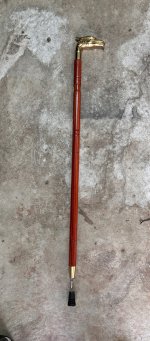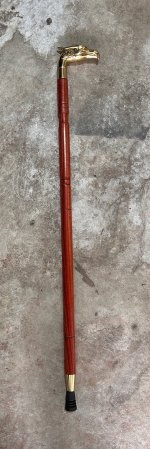A few years ago, I made a cane just as an experiment. My challenge was that a cane shaft is longer than the bedways of my lathe, so I came up with a solution that involved turning the shaft in three sections that I later joined together with dowels. That first cane was made of ash, but with walnut accents at the joints between shaft section.
Rather than using a commercial handle, I turned one on the lathe with a mortise on one end to receive the shaft. To make sure that the joint between the handle and the shaft was secure, and to reinforce the handle, I drilled a hole lengthwise through the handle and through the tenon on the end of the shaft, and epoxied in a fiberglass rod.
The project presented some interesting technical challenges, and was a lot of fun.
A few months later, wife took a fall and ended up needing a cane. She's shorter than me, so the cane I made was too long so I got to make another one*. This time, we were anticipating some travel and the need for her cane to fit into her carry on bag. So I made the shaft in four sections, but rather than using a glued dowel in the middle joint, I embedded a length of 3/8x16tpi allthread on one side of the joint, and a matching threaded insert in the other side so that joint could be disassembled.
Since then, I've made several others. One was made from a sapling I cut down in the forest behind the house so the shaft is a more natural form rather than straight turning.
* cane length should be tailored to match the user. Ideally, the cane should not be shorter than the dimension between the user's wrist and the floor when standing normally. A bit longer is OK.




